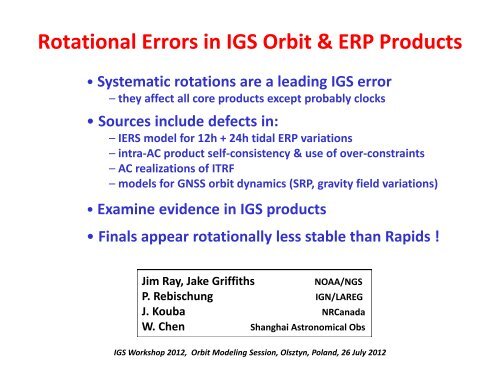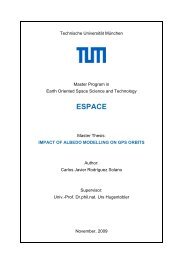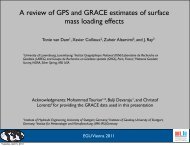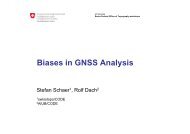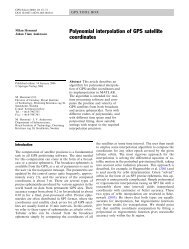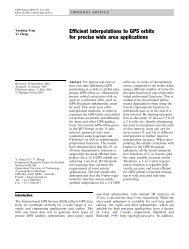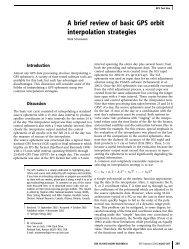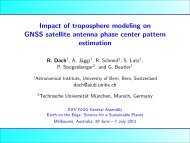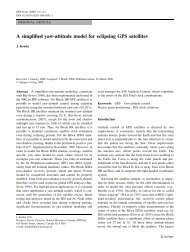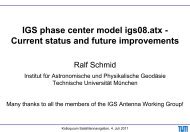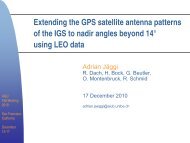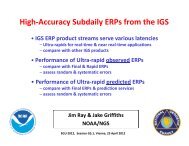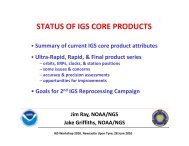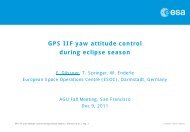Rotational Errors in IGS Orbit & ERP Products
Rotational Errors in IGS Orbit & ERP Products
Rotational Errors in IGS Orbit & ERP Products
Create successful ePaper yourself
Turn your PDF publications into a flip-book with our unique Google optimized e-Paper software.
<strong>Rotational</strong> <strong>Errors</strong> <strong>in</strong> <strong>IGS</strong> <strong>Orbit</strong> & <strong>ERP</strong> <strong>Products</strong><br />
• Systematic rotations are a lead<strong>in</strong>g <strong>IGS</strong> error<br />
– they affect all core products except probably clocks<br />
• Sources <strong>in</strong>clude defects <strong>in</strong>:<br />
– IERS model for 12h + 24h tidal <strong>ERP</strong> variations<br />
– <strong>in</strong>tra‐AC product self‐consistency & use of over‐constra<strong>in</strong>ts<br />
– AC realizations of ITRF<br />
– models for GNSS orbit dynamics (SRP, gravity field variations)<br />
• Exam<strong>in</strong>e evidence <strong>in</strong> <strong>IGS</strong> products<br />
• F<strong>in</strong>als appear rotationally less stable than Rapids !<br />
Jim Ray, Jake Griffiths NOAA/NGS<br />
P. Rebischung IGN/LAREG<br />
J. Kouba NRCanada<br />
W. Chen Shanghai Astronomical Obs<br />
<strong>IGS</strong> Workshop 2012, <strong>Orbit</strong> Model<strong>in</strong>g Session, Olsztyn, Poland, 26 July 2012
1. Subdaily <strong>ERP</strong> Tidal Variations<br />
• Ocean tides drive <strong>ERP</strong> variations near 12 & 24 hr periods<br />
– amplitudes reach ~1 mas level = ~13 cm shift @ GPS altitude<br />
– small atmosphere tides also exist at S1 & S2 periods (not modeled)<br />
– 1 st IERS model issued <strong>in</strong> 1996 for 8 ma<strong>in</strong> tides (R. Ray et al., 1994)<br />
– most <strong>IGS</strong> ACs implemented IERS model <strong>in</strong> 1996<br />
– 2003 model extended to 71 tide terms via admittances (R. Eanes, 2000)<br />
– also added small prograde diurnal polar motion libration <strong>in</strong> 2003<br />
– UT1 libration added <strong>in</strong> 2010<br />
– but ocean tide model still that of R. Ray et al. (1994)<br />
• Significant errors <strong>in</strong> IERS model def<strong>in</strong>itely exist<br />
– 10 to 20% differences us<strong>in</strong>g modern ocean tide models (R. Ray)<br />
– <strong>IGS</strong> polar motion rate discont<strong>in</strong>uities show alias signatures (J. Kouba)<br />
– direct tide model fits to GPS & VLBI data (various groups)<br />
– but empirical <strong>ERP</strong> tide models are subject to technique errors<br />
– would be very <strong>in</strong>terest<strong>in</strong>g to see empirical fit to SLR data too !<br />
– GNSS orbits esp sensitive to <strong>ERP</strong> tide errors due to orbital resonance<br />
02
Compute Polar Motion Discont<strong>in</strong>uities<br />
daily noon PM<br />
offset & rate<br />
estimates<br />
midnight PM<br />
discont<strong>in</strong>uities<br />
• Exam<strong>in</strong>e PM day‐boundary discont<strong>in</strong>uities for <strong>IGS</strong> time series<br />
– NOTE: PM‐rate segments are not cont<strong>in</strong>uous & should not be constra<strong>in</strong>ed !
Power Spectra of <strong>IGS</strong> PM Discont<strong>in</strong>uities<br />
PM‐x<br />
PM‐y<br />
• Common peaks seen <strong>in</strong> most AC spectra are:<br />
– annual + 5 th & 7 th harmonics of GPS year (351 d or 1.040 cpy)<br />
– aliased errors of subdaily <strong>ERP</strong> tide model
Spectra of Subdaily <strong>ERP</strong> Tide Model Differences<br />
PM‐x<br />
PM‐y<br />
• Compare TPXO7.1 & IERS <strong>ERP</strong> models<br />
– TPXO7.1 & GOT4.7 test models k<strong>in</strong>dly provided by Richard Ray<br />
– assume subdaily <strong>ERP</strong> model differences expressed fully <strong>in</strong> <strong>IGS</strong> PM results
Spectra of PM Discont<strong>in</strong>uities & Subdaily <strong>ERP</strong> <strong>Errors</strong><br />
PMx‐rates<br />
PMy‐rates<br />
subdaily <strong>ERP</strong><br />
model errors<br />
(TPXO7.1 vs IERS)<br />
effects of<br />
orbit model<br />
<strong>in</strong>teractions<br />
?<br />
• Alias<strong>in</strong>g of subdaily <strong>ERP</strong> tide model errors expla<strong>in</strong>s most peaks:<br />
– annual (K1, P1, T2), 14.2 d (O1), 9.4 d (Q1, N2), & 7.2 d (σ1, 2Q1, 2N2, µ2)<br />
• <strong>Orbit</strong> <strong>in</strong>teractions responsible for odd 1.04 cpy harmonics<br />
03
Simulated IERS <strong>ERP</strong> Tide Model <strong>Errors</strong><br />
<strong>in</strong>duced 3D errors<br />
← alias <strong>in</strong>to <strong>ERP</strong> parameters<br />
UT1 errors<br />
<strong>in</strong>troduced<br />
alias <strong>in</strong>to orbit parameters<br />
• Introduce admittance errors to IERS model at 10 to 20% level<br />
– simulated errors similar <strong>in</strong> magnitude to true model errors<br />
– 71 terms at 12h + 24h periods <strong>in</strong> each 1D component<br />
– <strong>in</strong> 3D, tidal errors beat to higher & lower frequencies<br />
04
Impact of Simulated <strong>ERP</strong> Model <strong>Errors</strong> on <strong>Orbit</strong>s<br />
• Subdaily <strong>ERP</strong> tidal errors alias <strong>in</strong>to comb of ~1 cpd harmonics<br />
– power <strong>in</strong> model error transfers very efficiently <strong>in</strong>to orbits<br />
05
Simulated <strong>ERP</strong> <strong>Errors</strong> vs Actual <strong>Orbit</strong> Discont<strong>in</strong>uities<br />
Aliased Power <strong>in</strong> Midnight <strong>Orbit</strong> Discont<strong>in</strong>uities<br />
• Ma<strong>in</strong> features of <strong>IGS</strong> orbits (top l<strong>in</strong>es) matched by <strong>ERP</strong> simulation<br />
– annual + 3 rd harmonic of GPS year (351 d or 1.040 cpy)<br />
– ~14d, ~9d, & ~7d subdaily <strong>ERP</strong> aliases<br />
– overall peak magnitudes alike but actual model errors could differ<br />
06
2. AC TRF, <strong>Orbit</strong>, & <strong>ERP</strong> Self‐Consistency<br />
• A constant rotational shift of AC TRF realization should offset<br />
orbit frame & polar motion (PM) equally<br />
– expect: TRF RX = orbit RX = ΔPMy & TRF RY = orbit RY = ΔPMx<br />
– AC’s process<strong>in</strong>g should preserve these physical relationships<br />
– this is basis for <strong>IGS</strong> F<strong>in</strong>al product “quasi‐rigorous” comb<strong>in</strong>ation method<br />
(J. Kouba et al., 1998)<br />
• But, 12h + 24h <strong>ERP</strong> errors can alias mostly <strong>in</strong>to empirical once‐<br />
per‐rev (12h) orbit parameters<br />
– e.g., due to errors <strong>in</strong> apriori IERS subdaily <strong>ERP</strong> tide model<br />
– does not equal any net rotation of TRF or <strong>ERP</strong>s<br />
• Likewise, any net diurnal s<strong>in</strong>usoidal wobble of satellite orbits will<br />
alias purely <strong>in</strong>to a <strong>ERP</strong> bias<br />
– e.g., due to systematic orbit model defect<br />
– does not equal any net rotation of TRF or orbit frame<br />
• So, check of AC rotational consistency can provide <strong>in</strong>sights <strong>in</strong>to<br />
analysis weaknesses<br />
– but most ACs apply some over‐constra<strong>in</strong>ts on orbit and/or PM variations !<br />
07
AC TRF & <strong>Orbit</strong> Frame Consistency<br />
← <strong>IGS</strong>05 <strong>IGS</strong>08 <br />
← <strong>IGS</strong>05<br />
<strong>IGS</strong>08 <br />
• Poor rotational self‐consistency by most ACs for RX & RY<br />
– apparently mostly due to AC orbit analysis effects, not RF realizations<br />
08
AC <strong>Orbit</strong> Frame & Polar Motion Consistency<br />
← <strong>IGS</strong>05 <strong>IGS</strong>08 <br />
← <strong>IGS</strong>05<br />
<strong>IGS</strong>08 <br />
• Similarly poor RX & RY consistencies between AC orbits & PM<br />
– change from <strong>IGS</strong>05 to <strong>IGS</strong>08 RF had m<strong>in</strong>imal impact<br />
dPM‐y<br />
dPM‐x<br />
09
AC TRF & Polar Motion Consistency<br />
← <strong>IGS</strong>05 <strong>IGS</strong>08 <br />
← <strong>IGS</strong>05<br />
• AC TRF & polar motions mostly much more consistent<br />
– except for a few ACs<br />
<strong>IGS</strong>08 <br />
dPM‐y<br />
dPM‐x<br />
10
3. Inter‐compare <strong>IGS</strong> <strong>Orbit</strong> Series<br />
• Expect differences due to TRF realizations<br />
– TRF tightly constra<strong>in</strong>ed to <strong>IGS</strong>xx for IGU/IGR<br />
– TRF only rotationally aligned to <strong>IGS</strong>xx for <strong>IGS</strong><br />
• Expect differences due to overall product quality<br />
– normally th<strong>in</strong>k <strong>IGS</strong> is best due to 9 ACs & quasi‐rigorous comb<strong>in</strong>ation<br />
methodology<br />
– <strong>IGS</strong> also uses more process<strong>in</strong>g time (up to ~10 d) & more stations<br />
– also has benefit of prior IGR & IGU results<br />
– IGR has 8 ACs & uses
2008<br />
±<br />
2009<br />
±<br />
2010<br />
±<br />
2011<br />
±<br />
Pairwise <strong>IGS</strong> <strong>Orbit</strong> Differences<br />
Ultra Observed Differences wrt Rapids (mm @ GPS altitude)<br />
dX dY dZ RX RY RZ SCL RMS wRMS Medi<br />
1.2<br />
1.1<br />
1.2<br />
0.8<br />
1.3<br />
1.0<br />
0.9<br />
1.0<br />
0.6<br />
1.2<br />
0.3<br />
0.9<br />
0.8<br />
0.9<br />
0.6<br />
0.8<br />
0.5<br />
1.7<br />
0.1<br />
1.3<br />
-0.7<br />
1.3<br />
-1.2<br />
1.3<br />
-3.0<br />
4.4<br />
-0.2<br />
3.4<br />
0.7<br />
3.8<br />
0.9<br />
3.3<br />
1.0<br />
4.2<br />
0.9<br />
3.4<br />
-0.9<br />
3.8<br />
-1.0<br />
3.7<br />
0.4<br />
15.6<br />
2.6<br />
12.7<br />
0.7<br />
10.9<br />
3.0<br />
8.8<br />
-3.0<br />
1.6<br />
-1.2<br />
1.5<br />
-1.7<br />
1.6<br />
-0.4<br />
1.1<br />
12.4<br />
2.8<br />
* rotations Rapid are equatorial Differences @ GPS altitude wrt F<strong>in</strong>als (mm @ GPS altitude)<br />
2008<br />
±<br />
2009<br />
±<br />
2010<br />
±<br />
2011<br />
±<br />
0.1<br />
0.8<br />
-0.3<br />
0.7<br />
-0.5<br />
0.7<br />
-0.1<br />
0.6<br />
0.1<br />
0.9<br />
0.3<br />
0.8<br />
-0.1<br />
0.8<br />
-0.2<br />
0.6<br />
-0.3<br />
1.5<br />
0.1<br />
1.3<br />
-0.1<br />
1.3<br />
-0.6<br />
1.7<br />
0.6<br />
3.3<br />
0.5<br />
4.7<br />
4.0<br />
5.8<br />
0.2<br />
4.4<br />
* rotations are equatorial @ GPS altitude<br />
-5.1<br />
4.4<br />
-5.4<br />
3.6<br />
-1.9<br />
5.2<br />
-2.8<br />
4.6<br />
-2.5<br />
3.8<br />
-4.6<br />
4.6<br />
0.8<br />
3.8<br />
-2.8<br />
3.8<br />
1.3<br />
1.2<br />
1.2<br />
1.0<br />
-0.4<br />
1.2<br />
-1.8<br />
1.2<br />
9.0<br />
1.6<br />
9.4<br />
1.9<br />
7.8<br />
1.3<br />
6.9<br />
1.0<br />
5.8<br />
0.7<br />
5.7<br />
0.7<br />
5.6<br />
0.6<br />
11.2<br />
1.9<br />
8.0<br />
1.3<br />
8.3<br />
1.4<br />
7.1<br />
1.1<br />
6.6<br />
1.1<br />
5.6<br />
0.7<br />
5.5<br />
0.6<br />
5.4<br />
0.6<br />
10.4<br />
1.7<br />
7.2<br />
1.2<br />
7.5<br />
1.3<br />
6.4<br />
1.0<br />
6.2<br />
1.0<br />
5.1<br />
0.7<br />
5.0<br />
0.6<br />
4.9<br />
0.6
Pairwise <strong>IGS</strong> <strong>Orbit</strong> Differences<br />
RX/RY rotations more similar for IGU & IGR RZ & WRMS/MEDI worse for IGU<br />
2008<br />
±<br />
2009<br />
±<br />
2010<br />
±<br />
2011<br />
±<br />
Ultra Observed Differences wrt Rapids (mm @ GPS altitude)<br />
dX dY dZ RX RY RZ SCL RMS wRMS Medi<br />
1.2<br />
1.1<br />
1.2<br />
0.8<br />
1.3<br />
1.0<br />
0.9<br />
1.0<br />
0.6<br />
1.2<br />
0.3<br />
0.9<br />
0.8<br />
0.9<br />
0.6<br />
0.8<br />
0.5<br />
1.7<br />
0.1<br />
1.3<br />
-0.7<br />
1.3<br />
-1.2<br />
1.3<br />
-3.0<br />
4.4<br />
-0.2<br />
3.4<br />
0.7<br />
3.8<br />
0.9<br />
3.3<br />
1.0<br />
4.2<br />
0.9<br />
3.4<br />
-0.9<br />
3.8<br />
-1.0<br />
3.7<br />
0.4<br />
15.6<br />
2.6<br />
12.7<br />
0.7<br />
10.9<br />
3.0<br />
8.8<br />
-3.0<br />
1.6<br />
-1.2<br />
1.5<br />
-1.7<br />
1.6<br />
-0.4<br />
1.1<br />
12.4<br />
2.8<br />
* rotations Rapid are equatorial Differences @ GPS altitude wrt F<strong>in</strong>als (mm @ GPS altitude)<br />
2008<br />
±<br />
2009<br />
±<br />
2010<br />
±<br />
2011<br />
±<br />
0.1<br />
0.8<br />
-0.3<br />
0.7<br />
-0.5<br />
0.7<br />
-0.1<br />
0.6<br />
0.1<br />
0.9<br />
0.3<br />
0.8<br />
-0.1<br />
0.8<br />
-0.2<br />
0.6<br />
-0.3<br />
1.5<br />
0.1<br />
1.3<br />
-0.1<br />
1.3<br />
-0.6<br />
1.7<br />
0.6<br />
3.3<br />
0.5<br />
4.7<br />
4.0<br />
5.8<br />
0.2<br />
4.4<br />
-5.1<br />
4.4<br />
-5.4<br />
3.6<br />
-1.9<br />
5.2<br />
-2.8<br />
4.6<br />
-2.5<br />
3.8<br />
-4.6<br />
4.6<br />
0.8<br />
3.8<br />
1.3<br />
1.2<br />
1.2<br />
1.0<br />
-0.4<br />
1.2<br />
9.0<br />
1.6<br />
9.4<br />
1.9<br />
7.8<br />
1.3<br />
6.9<br />
1.0<br />
5.8<br />
0.7<br />
5.7<br />
0.7<br />
11.2<br />
1.9<br />
8.0<br />
1.3<br />
8.3<br />
1.4<br />
7.1<br />
1.1<br />
6.6<br />
1.1<br />
5.6<br />
0.7<br />
5.5<br />
0.6<br />
10.4<br />
1.7<br />
* rotations are equatorial @ GPS altitude 12<br />
-2.8<br />
3.8<br />
-1.8<br />
1.2<br />
5.6<br />
0.6<br />
5.4<br />
0.6<br />
7.2<br />
1.2<br />
7.5<br />
1.3<br />
6.4<br />
1.0<br />
6.2<br />
1.0<br />
5.1<br />
0.7<br />
5.0<br />
0.6<br />
4.9<br />
0.6
Compare IGR & <strong>IGS</strong> PPP Network Solutions<br />
• Compute daily PPP solutions for global network of RF stations<br />
– align daily frame solutions to <strong>IGS</strong> long‐term RF<br />
• IGR RX & RY stabilities much better than for <strong>IGS</strong><br />
– RZ performance similar for IGR & <strong>IGS</strong><br />
– 3D station position WRMS much lower for <strong>IGS</strong>, probably due to better <strong>IGS</strong> clocks<br />
• PPP results consistent with better RX/RY rotations for Rapids<br />
PPP Global Soln<br />
Mean ± Std Dev<br />
RX<br />
(μas)<br />
RY<br />
(μas)<br />
RZ<br />
(μas)<br />
3D WRMS<br />
(mm)<br />
(wrt <strong>IGS</strong> RF) IGR <strong>IGS</strong> IGR <strong>IGS</strong> IGR <strong>IGS</strong> IGR <strong>IGS</strong><br />
2008<br />
2009<br />
2010<br />
2011<br />
‐23.1<br />
± 24.4<br />
‐21.5<br />
± 28.4<br />
‐38.4<br />
± 31.4<br />
‐4.8<br />
± 37.3<br />
‐14.8<br />
± 30.7<br />
‐14.2<br />
± 36.4<br />
‐38.8<br />
± 44.2<br />
‐4.1<br />
± 46.8<br />
29.9<br />
± 26.8<br />
23.8<br />
± 29.2<br />
24.4<br />
± 30.2<br />
41.1<br />
± 31.6<br />
61.0<br />
± 40.1<br />
66.3<br />
± 34.6<br />
41.5<br />
± 42.8<br />
37.8<br />
± 39.6<br />
‐36.2<br />
± 47.7<br />
‐40.6<br />
± 47.6<br />
‐8.1<br />
± 44.1<br />
‐9.3<br />
± 32.2<br />
‐38.0<br />
± 46.1<br />
‐34.3<br />
± 47.4<br />
‐19.3<br />
± 28.7<br />
0.1<br />
± 30.7<br />
8.24<br />
±1.09<br />
8.74<br />
±0.91<br />
8.76<br />
±0.90<br />
8.55<br />
±0.92<br />
7.67<br />
±1.09<br />
7.92<br />
±1.05<br />
7.57<br />
± 0.76<br />
7.73<br />
± 0.72<br />
13
IGU, IGR, & <strong>IGS</strong> PPP Network RX/RY Rotations<br />
IGU rejections<br />
tightened<br />
<strong>IGS</strong>05 <strong>IGS</strong>08<br />
• RX/RY<br />
variations<br />
clearly greater<br />
for F<strong>in</strong>als than<br />
Rapids<br />
• change from<br />
<strong>IGS</strong>05 to <strong>IGS</strong>08<br />
RFs had no<br />
obvious affect<br />
• IGU rotations<br />
much larger<br />
• IGU stability<br />
improved when<br />
reject threshold<br />
tightened from<br />
1.0 to 0.5 mas<br />
on 2011‐09‐15<br />
(MJD 55819)
Compare IGR & <strong>IGS</strong> Long‐Arc <strong>Orbit</strong> Fits<br />
• Compute orbit fits over weekly <strong>in</strong>tervals (long‐arc)<br />
– use the CODE Extended model (6 + 9)<br />
• Performance differences are quite small<br />
– F<strong>in</strong>als slightly better by all long‐arc metrics over 2008‐2011<br />
• But long‐period rotations have m<strong>in</strong>imal impact on 7‐d long‐arc fits<br />
– IGR & <strong>IGS</strong> orbit quality probably very similar over daily to weekly periods<br />
Long-Arc <strong>Orbit</strong><br />
Residuals<br />
2008<br />
2009<br />
2010<br />
2011<br />
Total WRMS<br />
(all SVs, mm)<br />
Non-Eclipse<br />
WRMS (mm)<br />
Median RMS<br />
(mm)<br />
IGR <strong>IGS</strong> IGR <strong>IGS</strong> IGR <strong>IGS</strong><br />
24.6<br />
±6.4<br />
24.5<br />
±4.6<br />
25.3<br />
±5.4<br />
25.8<br />
±5.4<br />
24.2<br />
±4.0<br />
23.6<br />
±4.1<br />
23.4<br />
±4.5<br />
24.4<br />
±4.4<br />
21.0<br />
±5.5<br />
20.9<br />
±4.2<br />
22.1<br />
±6.0<br />
22.2<br />
±5.6<br />
20.4<br />
±3.4<br />
19.9<br />
±3.2<br />
19.8<br />
±2.9<br />
21.0<br />
±4.2<br />
20.5<br />
±4.8<br />
19.8<br />
±2.9<br />
19.5<br />
±2.5<br />
20.3<br />
±3.0<br />
19.9<br />
±2.6<br />
19.5<br />
±2.9<br />
19.2<br />
±2.5<br />
20.2<br />
±2.9 14
4. Inter‐compare <strong>IGS</strong> Polar Motion Series<br />
IGb00<br />
(Ultra Observed –F<strong>in</strong>al) PM Differences<br />
(Rapid –F<strong>in</strong>al) PM Differences<br />
(4 Nov 2006)<br />
(~18 Mar 2008)<br />
<strong>IGS</strong>05/08 <br />
IGUs improved due to AC<br />
& comb<strong>in</strong>ation changes <br />
dPM‐x<br />
dPM‐y<br />
• s<strong>in</strong>ce ~2008,<br />
IGU & IGR<br />
agree better<br />
with each<br />
other than<br />
with <strong>IGS</strong> F<strong>in</strong>als<br />
• <strong>IGS</strong> F<strong>in</strong>als PM<br />
series shows<br />
low‐frequency<br />
systematic<br />
components<br />
• but more<br />
IGU high‐<br />
frequency<br />
noise & some<br />
dPM‐y<br />
deviations <strong>in</strong><br />
2012<br />
15
Differences Among <strong>IGS</strong> Polar Motion Series<br />
(Ultra Observed –Rapid) PM Differences • IGU & IGR<br />
more similar<br />
to each other<br />
than to F<strong>in</strong>als<br />
dPM‐x<br />
dPM‐y<br />
• subdaily <strong>ERP</strong><br />
alias peaks<br />
imply not all<br />
ACs use IERS<br />
model (esp <strong>in</strong><br />
IGUs) !<br />
16
3 Cornered Hat Decomposition of <strong>ERP</strong> <strong>Errors</strong><br />
• 3 cornered hat method is sensitive to uncorrelated, random errors<br />
– for time series {i, j, k} form time series of differences (i‐j), (j‐k), (i‐k)<br />
– then Var(i‐j) = Var (i) + Var(j) (assum<strong>in</strong>g R ij = 0 for i ≠ j)<br />
– and Var(i) = [Var(i‐j) + Var(i‐k) –Var(j‐k)] / 2<br />
– but true errors also <strong>in</strong>clude common‐mode effects removed <strong>in</strong> differenc<strong>in</strong>g<br />
• Apply to <strong>IGS</strong> Ultra (observed), Rapid, & F<strong>in</strong>al PM & dLOD<br />
– consider recent 1461 d from 1 Jan 2008 to 31 Dec 2011<br />
• Surpris<strong>in</strong>g results:<br />
– apparently, Rapids give best polar motion & Ultras give best dLOD<br />
– Ultras give similar quality polar motion as F<strong>in</strong>als<br />
– perhaps F<strong>in</strong>als affected by weaknesses <strong>in</strong> AC quasi‐rigorous procedures ?<br />
<strong>IGS</strong> Product σ(PM-x) σ(PM-y) σ(dLOD)<br />
Series<br />
(μas)<br />
(μas)<br />
(μs)<br />
Ultra (Obs) 25.8 27.6 4.99<br />
Rapid 16.0 15.4 5.69<br />
F<strong>in</strong>al 25.3 31.3 9.19<br />
17
3 Cornered Hat PM Results with High‐Pass Filter<strong>in</strong>g<br />
• Apply Vondrak high‐pass filter before 3 cornered hat for PM<br />
– try 4 cutoff frequencies: pass all, >0.5 cpy, >1 cpy, >2 cpy<br />
• IGU & IGR PM errors nearly <strong>in</strong>sensitive to frequency filter<strong>in</strong>g<br />
• <strong>IGS</strong> F<strong>in</strong>al PM appears to improve when high‐pass filtered<br />
– implies low‐frequency errors are <strong>in</strong> <strong>IGS</strong> F<strong>in</strong>als or common to IGU & IGR<br />
– AAM+OAM excitations not accurate enough to dist<strong>in</strong>guish <strong>IGS</strong> series<br />
– <strong>ERP</strong>s from other techniques are much less accurate also<br />
– so must use other <strong>in</strong>ternal <strong>IGS</strong> metrics to study low‐frequency rotational<br />
stability of Rapid & F<strong>in</strong>al products<br />
more low frequencies removed <br />
Freq Cutoff: none 0.5 cpy 1 cpy 2 cpy<br />
σ x σ y σ x σ y σ x σ y σ x σ y<br />
Ultra (Obs) (μas) 25.8 27.6 24.2 25.5 24.1 23.7 23.7 22.5<br />
Rapid (μas) 16.0 15.4 16.2 14.6 15.6 16.1 15.2 16.8<br />
F<strong>in</strong>al (μas) 25.3 31.3 20.2 23.1 19.4 19.7 18.5 17.3<br />
18
Conclusions<br />
• Defects <strong>in</strong> IERS subdaily <strong>ERP</strong> model are major <strong>IGS</strong> error source<br />
– probably ma<strong>in</strong> source of pervasive draconitic signals <strong>in</strong> all products<br />
– little prospect for significant improvements <strong>in</strong> near future<br />
– ILRS should be strongly urged to estimate empirical model from SLR data,<br />
for comparison with GPS & VLBI results<br />
– not all ACs (e.g., IGUs) appear to use correct IERS model<br />
• Over ~annual scales, F<strong>in</strong>al products appear rotationally less<br />
stable than Rapids<br />
– appears to affect <strong>IGS</strong> polar motion<br />
– also seems to affect RX/RY stability of <strong>IGS</strong> orbit & PPP results<br />
– probably due to <strong>in</strong>adequate <strong>in</strong>tra‐AC self‐consistency <strong>in</strong> F<strong>in</strong>als<br />
– situation might improve (<strong>in</strong>advertently) when F<strong>in</strong>als move from weekly to<br />
daily TRF <strong>in</strong>tegrations<br />
– quasi‐rigorous method should be re‐exam<strong>in</strong>ed<br />
• Further study of long‐term dynamical stability of <strong>IGS</strong> products<br />
will be limited till these issues are resolved<br />
19
Backup Slides
AC PM Results from SNX & <strong>Orbit</strong> Comb<strong>in</strong>ations<br />
residuals after remov<strong>in</strong>g TRF rotations<br />
← <strong>IGS</strong>05 <strong>IGS</strong>08 <br />
← <strong>IGS</strong>05<br />
TRF rotations not removed<br />
<strong>IGS</strong>08 <br />
dPM‐x


